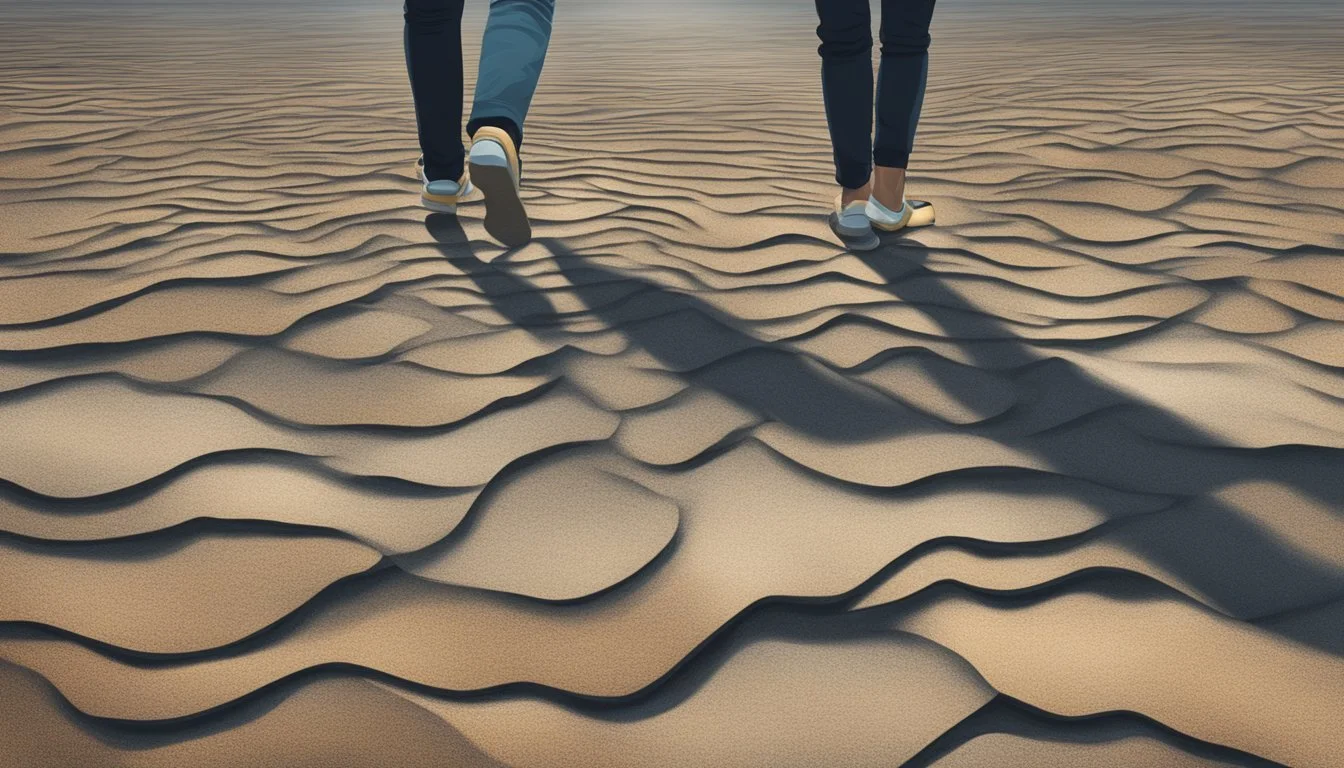13 Grounding Techniques for Managing PTSD-Related Agoraphobia
Effective Strategies for Daily Life
Dealing with PTSD-related agoraphobia can be incredibly challenging, often making it difficult for individuals to engage in everyday activities outside the safety of their homes. These intense feelings of fear and anxiety can significantly impact one's quality of life.
Implementing grounding techniques can be a valuable strategy to alleviate symptoms associated with PTSD and agoraphobia. These methods aim to help individuals stay connected to the present moment, reducing the intensity of anxiety and fear. Various techniques offer practical ways to maintain a sense of calm and control during overwhelming situations.
1) 5-4-3-2-1 Grounding Exercise
The 5-4-3-2-1 Grounding Exercise is a simple and effective way to manage anxiety and stress, particularly in those with PTSD-related agoraphobia. This technique helps individuals focus on the present moment by using their senses.
This exercise involves identifying 5 things you can see, 4 things you can touch, 3 things you can hear, 2 things you can smell, and 1 thing you can taste. By engaging with these sensory inputs, it helps shift attention from distressing thoughts to immediate surroundings.
The method is particularly useful in high-stress situations, providing a structured way to calm the mind and body. For example, noticing the texture of an object or the distant sound of traffic can bring a sense of calm and presence.
By practicing this regularly, individuals can better manage episodes of anxiety and slowly build resilience against overwhelming situations. More about the techniques for sensory grounding can be found at Verywell Mind.
This grounding exercise can be practiced anywhere and does not require any special equipment, making it accessible for daily use. More details on similar techniques are available at Therapist Aid.
2) Deep Breathing Techniques
Deep breathing techniques are effective for managing PTSD-related agoraphobia. By focusing on controlled breathing, individuals can help calm their nervous system and reduce anxiety.
One method to practice is diaphragmatic breathing. This involves breathing deeply into the diaphragm rather than shallowly into the chest. Sitting or lying comfortably, place one hand on your chest and the other on your stomach. Breathe in slowly through the nose, ensuring the hand on your stomach rises.
Another technique is box breathing. This method involves inhaling for four counts, holding the breath for four counts, exhaling for four counts, and holding the breath again for four counts. Repeat the cycle several times to achieve a calming effect.
Alternate nostril breathing can also be beneficial. This technique involves closing one nostril, inhaling through the other, and then alternating nostrils with each breath. It helps to balance the left and right sides of the brain, promoting relaxation.
These techniques can be practiced daily to build resilience against anxiety. By integrating them into a routine, individuals may find relief from symptoms associated with PTSD and agoraphobia. Consistent practice is key to experiencing the benefits fully.
Learn more about these techniques and their benefits on breathing techniques for PTSD and PDF Breathing Exercise.
3) Progressive Muscle Relaxation
Progressive Muscle Relaxation (PMR) is an effective technique for reducing anxiety and tension associated with PTSD-related agoraphobia. It involves systematically tensing and then relaxing different muscle groups in the body.
The practice aims to raise awareness of physical sensations and alleviate stress. This method is grounded in the principle that muscle relaxation follows muscle tension.
Doing PMR regularly can help interrupt the cycle of chronic tension and anxiety. It can guide individuals to distinguish between muscle tension caused by stress and a more relaxed state.
PMR often starts with the feet and progresses upward, systematically targeting each muscle group. This structured approach ensures comprehensive relaxation.
Numerous mental health professionals recommend PMR due to its efficacy. Studies and clinical experiences suggest that PMR can significantly reduce symptoms of anxiety and improve overall well-being.
This technique is widely used in therapeutic settings and can be combined with other grounding methods. For more details and comprehensive scripts, this guide provides valuable resources.
Incorporating PMR into daily routines can provide individuals with an additional tool to manage anxiety levels effectively. It is particularly beneficial for those experiencing agoraphobia as it can be practiced anywhere.
4) Cold Water Splashes
Using cold water splashes is an effective grounding technique for managing PTSD-related agoraphobia. This method can quickly bring someone back to the present moment by triggering physical sensations.
Splashing cold water on the face or running it over the hands can help interrupt distressing thoughts and feelings.
This technique is easy to implement anywhere with access to water. For a more intense experience, immersing the hands or face in ice water can provide a stronger grounding effect.
Cold water engages the body’s physical response, which can reduce anxiety symptoms. It activates the body's natural relaxation response, helping to lower heart rate and calm the mind.
For those experiencing severe distress, carrying a small spray bottle filled with cold water can be a portable solution. This allows for quick application when needed.
Cold showers or baths serve as alternatives, providing a comprehensive cooling effect. Regular use of cold water splashes can be a simple yet powerful tool in managing symptoms associated with agoraphobia and PTSD.
Additional ideas include alternating between warm and cold water to enhance sensory stimulation. This contrast can further help ground individuals when they feel overwhelmed.
Using cold water is a straightforward, accessible way to regain control during moments of anxiety or panic.
5) Counting Backwards from 100
Counting backwards from 100 can be a highly effective grounding technique, especially for those dealing with PTSD-related agoraphobia. This method requires concentration, helping to shift focus away from anxiety-inducing thoughts.
Starting at 100, individuals count down in increments of three. For example, 100, 97, 94, and so on. This mental exercise engages the brain and distracts from distressing feelings.
This technique is easily accessible and can be performed anywhere. There is no need for special equipment or a designated space, making it convenient for use in various situations.
It's a straightforward process, which means it's suitable for people of all ages and mental states. Whether at home, work, or outdoors, this method serves as a quick tool for immediate relief.
Counting backwards from 100 not only diverts attention but also employs simple arithmetic, which requires just enough cognitive effort to be effective. The repetitive nature can also induce a calming effect. More details on this technique can be found on 25 Grounding Techniques to Support Mental Wellness.
6) Describing Surroundings in Detail
Describing one's surroundings in detail can be a powerful grounding technique for managing PTSD-related agoraphobia. This method engages the senses and focuses attention on the present moment.
The individual should start by identifying and naming objects around them. For example, they might notice a red chair, a wooden table, or a blue curtain.
They can also describe textures, shapes, and colors. Mention how the fabric of the chair feels or the pattern on the table's surface.
Paying attention to smells and sounds in the environment can also be beneficial. They might note the scent of fresh coffee or the sound of birds chirping outside.
Focusing on these details helps shift attention away from distressing thoughts. This technique can make the environment feel less overwhelming and more manageable.
By continually practicing this method, individuals may find it easier to remain calm and grounded during moments of anxiety. This simple exercise can be done anywhere, making it accessible and straightforward to apply.
7) Visualization of a Safe Place
Visualization of a safe place is a powerful grounding technique for those experiencing PTSD-related agoraphobia. This practice involves imagining a place where one feels completely at ease and secure.
The safe place can be real or imaginary. It could be a location one has visited or a serene spot created in the mind. The key is to choose a place that evokes calm and safety.
To start, one should find a quiet environment free from distractions. Closing the eyes and taking a few deep breaths can help to relax and focus the mind.
Next, imagine the details of the safe place. Pay attention to the colors, shapes, and surroundings. Feel the textures and notice any sounds or smells. Engaging all senses in the visualization enhances its effectiveness.
Safe place visualization can be used during moments of anxiety, flashbacks, or intrusive thoughts. It provides a mental retreat to regain composure and reduce stress. Consistent practice can improve the ability to ground and center oneself quickly.
For more information on how to practice this technique, you can refer to guides like Safe Place Visualisation and Relaxing 'Safe Place' Imagery. These resources offer detailed instructions to help integrate this method into daily routines.
8) Holding an Ice Cube
Holding an ice cube is a practical grounding technique for managing PTSD-related agoraphobia. The cold sensation from the ice cube helps shift focus away from distressing thoughts or feelings.
Engaging the sense of touch is effective in bringing attention to the present moment. It's a simple yet physical way to interrupt a negative mental cycle.
An individual can hold the ice cube until it melts partially or until the cold sensation becomes intense. This approach works because the brain naturally attends to the strong physical stimulus.
For best results, combine holding an ice cube with deep breathing techniques. Slowly inhale and exhale, synchronizing the breaths with the cooling sensation in the hand.
This technique is portable and can be used discreetly in various settings, allowing one to manage symptoms without drawing attention.
Incorporate holding an ice cube into a regular grounding practice. This ensures the technique becomes familiar and more effective over time.
9) Listening to Nature Sounds
Listening to nature sounds can be an effective grounding technique for managing PTSD-related agoraphobia. Engaging with sounds such as birds chirping, waves crashing, or leaves rustling can invoke a sense of peace.
Creating a playlist of these soothing sounds can be helpful. He or she can turn to this playlist during moments of heightened anxiety. This practice can help bring focus back to the present moment.
Using headphones can enhance the experience by blocking out distracting noises. Incorporating guided meditations that feature nature sounds provides an additional layer of support.
Exploring different types of nature sounds helps find what works best for an individual. They might prefer rain sounds while someone else finds ocean waves more calming.
Listening to nature sounds is accessible and can be done almost anywhere. Taking a few minutes out of the day to relax and listen can make a significant difference.
When feeling overwhelmed in public spaces, this technique offers a discrete way to manage symptoms. Simply closing the eyes and immersing oneself in these sounds can create a quick escape to a tranquil mental space.
10) Touching Grounded Objects like Stones
Touching grounded objects like stones can help those with PTSD-related agoraphobia stay present and centered. The texture and weight of the stones provide sensory input, creating a calming effect.
Natural objects, especially stones, are often cool and smooth to the touch. This tactile sensation can distract the mind from anxious thoughts. The grounding effect is immediate, making it effective during moments of intense anxiety.
Incorporating stones into daily routines can be simple. Carry a small stone in a pocket or keep one on a desk. During stressful moments, holding the stone and focusing on its texture can bring relief.
Using stones is a practical grounding technique. It requires no special skills or equipment, making it accessible for anyone. This method can be used anywhere, whether at home or in public spaces.
Focusing on the physical properties of the stone, like its temperature and surface, redirects attention away from anxiety triggers. This shift in focus can help interrupt the cycle of panic and stress.
Experimenting with different types of stones can also enhance this technique. People can find the texture and weight that they find most comforting and effective for their needs.
In conclusion, using stones is a straightforward, yet powerful tool for managing PTSD-related agoraphobia. By incorporating this technique, individuals can experience a greater sense of calmness and control in their daily lives.
11) Positive Affirmations
Positive affirmations can be a powerful tool for grounding and managing PTSD-related agoraphobia.
Repeating affirmations helps rewire negative thought patterns. Phrases like "I am in control of my emotions" or "I am safe in this moment" can instill a sense of calm. These statements serve as reminders that the individual is capable of handling their anxiety.
Affirmations like "With each breath, I draw fresh, healing energy into my body" can reinforce a connection to the present moment. They encourage mindfulness and can reduce feelings of panic.
"Wherever I am, I feel at home—grounded and at peace" asserts a sense of belonging and security, helping to diminish the fear of open or crowded spaces. Regular use of such affirmations can gradually build a sense of inner strength and resilience.
Creating a personalized list of affirmations, tailored to specific anxieties and fears, can make this practice even more effective. Speaking these affirmations aloud or writing them down can enhance their impact, offering a tangible method to counteract the distressing symptoms of PTSD-related agoraphobia.
For more examples of grounding affirmations, consider checking resources like Mindful Zen. Their list of affirmations aims to help individuals feel centered and safe. Integrating these affirmations into daily routines can support ongoing emotional stability.
12) "This too shall pass" - Unknown
The phrase "This too shall pass" is a powerful reminder often used to cope with moments of intense anxiety or distress. It is particularly useful for those dealing with PTSD-related agoraphobia.
Repeating this mantra helps individuals remind themselves that current struggles are temporary. It encourages a mindset of resilience and patience.
People experiencing panic or anxiety can benefit from using this phrase to shift focus away from the immediate crisis. By acknowledging that these feelings are fleeting, they can find a sense of calm and perspective.
Consistent use of this phrase can build mental strength. It reinforces the belief that difficult times will eventually subside. This mental reinforcement can be crucial for managing moments of agoraphobia.
Engaging with this phrase during episodes of stress can make a significant difference. It’s a simple yet effective tool to help individuals ground themselves and regain control.
13) Mindful Walking
Mindful walking can be a powerful grounding technique for managing PTSD-related agoraphobia. This practice involves walking slowly and deliberately while focusing on the sensations of each step. It helps individuals stay present and connected to their surroundings.
Begin by finding a safe and comfortable place to walk. This could be indoors or in a peaceful outdoor environment. Pay attention to the feeling of your feet making contact with the ground.
Notice the weight shifting from heel to toe, the texture of the surface, and the rhythm of your breathing. As you walk, keep your eyes gently focused ahead, observing any sights, sounds, or smells without judgment.
If your mind begins to wander, gently bring your focus back to the sensations of walking. This redirection helps anchor the mind and reduces anxiety. Engage all your senses to deepen the experience.
Incorporating mindful walking into a daily routine can help create a sense of control and calm. Over time, it may also reduce the fear associated with leaving home, making it a valuable tool for those dealing with PTSD-related agoraphobia.
To learn more about grounding techniques, you can refer to resources like Mindfulness and Grounding Techniques in PTSD Management.
Understanding PTSD-Related Agoraphobia
PTSD-related agoraphobia links traumatic stress disorder to the fear of open or crowded places. This connection often arises from the overwhelming anxiety experienced during public or open situations following a traumatic event.
Defining PTSD and Agoraphobia
Post-Traumatic Stress Disorder (PTSD) is a mental health condition triggered by a terrifying event. Symptoms include flashbacks, severe anxiety, and uncontrollable thoughts about the event.
Agoraphobia, on the other hand, is the fear of being in situations where escape might be difficult, or help might not be available during a panic attack. It's not just about open spaces but concerns places where one feels trapped or helpless.
Combining these two disorders, PTSD-related agoraphobia involves significant stress and avoidance of environments that could trigger traumatic memories, often leading to extreme social withdrawal and isolation.
How PTSD Can Lead to Agoraphobia
A traumatic event can cause lasting changes in the brain's fear and anxiety circuits. These changes might make it difficult for individuals to distinguish between safe and threatening environments.
In these cases, memories of the trauma can become intertwined with the physical locations where they occurred. As a result, individuals may start to avoid any place that reminds them of the trauma.
This avoidance can spiral, leading to an inability to feel safe in any public or unfamiliar environment. Initial avoidance behaviors can expand, resulting in full-blown agoraphobia where even everyday tasks become daunting.
Common Symptoms of PTSD-Related Agoraphobia
Symptoms of PTSD-related agoraphobia are a blend of both conditions. They include intense fear or anxiety when in open or unfamiliar places, coupled with typical PTSD symptoms like flashbacks and hypervigilance.
Other symptoms encompass physical reactions like sweating, increased heart rate, and nausea when in triggering environments. There might also be an overwhelming urge to escape or avoid those places entirely.
Emotionally, sufferers may feel intense dread, helplessness, and panic. Behavioral symptoms involve isolation, avoiding social interactions, and possibly relying on others to accompany them whenever they leave home.
The Importance of Grounding Techniques
Grounding techniques are essential tools for individuals coping with PTSD-related agoraphobia. They provide immediate relief from distressing symptoms and promote psychological well-being.
How Grounding Techniques Help
Grounding techniques help by bringing the person's focus to the present moment. This can be crucial for someone experiencing intense anxiety or panic due to PTSD-related agoraphobia. For instance, focusing on sensory inputs like the texture of an object or the sensation of one's feet on the ground can divert attention from distressing thoughts.
These methods work by engaging the five senses: sight, sound, touch, taste, and smell. Simple activities like holding an ice cube or listening to calming music can quickly reduce anxiety levels. These immediate distractions prevent the mind from spiraling into trauma-related thoughts.
Psychological Benefits
Grounding techniques offer numerous psychological benefits. By shifting attention away from negative thoughts and feelings, they help reduce symptoms of anxiety and panic. This shift can create a mental break from the trauma experienced by individuals, thereby lowering stress levels.
Using grounding techniques consistently can also foster a sense of control and empowerment. When individuals know they have effective tools to combat their anxiety, their confidence in managing PTSD-related symptoms increases. This is crucial for long-term mental health and resilience.
Moreover, these techniques can be easily integrated with therapy and medication. Therapists often recommend them as part of a comprehensive treatment plan that includes cognitive-behavioral therapy (CBT) and other therapeutic modalities.
Improving Daily Functionality
Grounding techniques significantly improve daily functionality for those affected by PTSD-related agoraphobia. By providing a way to manage anxiety, these methods enable individuals to engage in daily activities they might otherwise avoid. Tasks such as shopping, attending social events, or even stepping outside can become more manageable.
These techniques can also enhance productivity at work and improve concentration. When anxiety levels are controlled, individuals find it easier to focus on tasks at hand. This leads to better performance and greater satisfaction in professional settings.
Additionally, the ability to manage symptoms on the go makes grounding techniques versatile and practical for real-life situations. Whether at home or in public, quick grounding exercises can provide the necessary support to navigate challenging environments.
Choosing the Right Grounding Techniques
Selecting suitable grounding techniques involves understanding personal preferences and consulting with professionals. Individual needs and circumstances significantly influence the effectiveness of particular methods.
Personalizing Your Approach
Each person experiences PTSD-related agoraphobia differently. Identifying techniques that align with personal interests and comfort levels is crucial. For instance, physical grounding methods such as stretching or jogging in place can be particularly effective for those who respond well to movement and physical activity.
Moreover, some might find tactile grounding methods, like holding a grounding stone or touching various textures, most beneficial. Using sensory experiences to reconnect with the present moment can help manage overwhelming emotions. Additionally, cognitive grounding, such as creating lists of favorite things or visualizing a safe place, can offer a mental escape and promote calm.
Tips for Personalization:
Experiment with different techniques to see which ones resonate most.
Consider incorporating grounding techniques into daily routines for better results.
Stay flexible and open to changing strategies as needs evolve.
Consulting Professionals
Professional guidance can refine and tailor grounding techniques to suit individual challenges. Mental health professionals, such as therapists or counselors, often have extensive knowledge of various grounding methods and can recommend specific strategies. Collaboration with professionals ensures that chosen techniques are safe and effective.
Therapists can also provide structured plans for incorporating grounding techniques into therapeutic sessions. Whether through cognitive-behavioral therapy (CBT) or other modalities, professional input can significantly aid in managing PTSD-related agoraphobia.
Benefits of Professional Consultation:
Access to expert insight on diverse grounding methods.
Customized plans that consider personal history and triggers.
Continuous support and adjustment based on progress and feedback.
Users can reach out to platforms such as Talkspace for professional advice and psychotherapy options. Additionally, resources like Verywell Mind offer comprehensive insights into grounding techniques and their applications.








